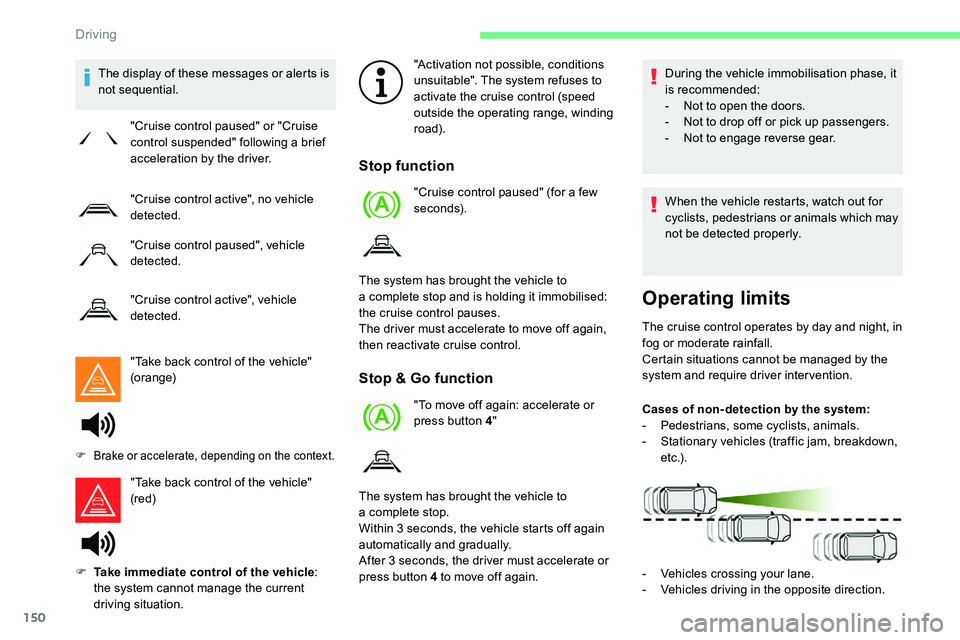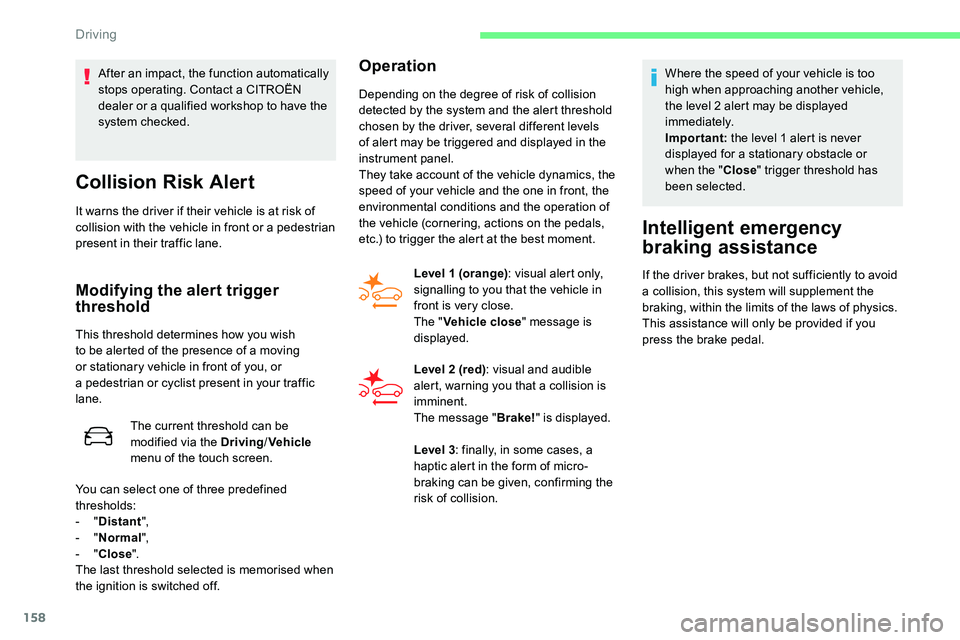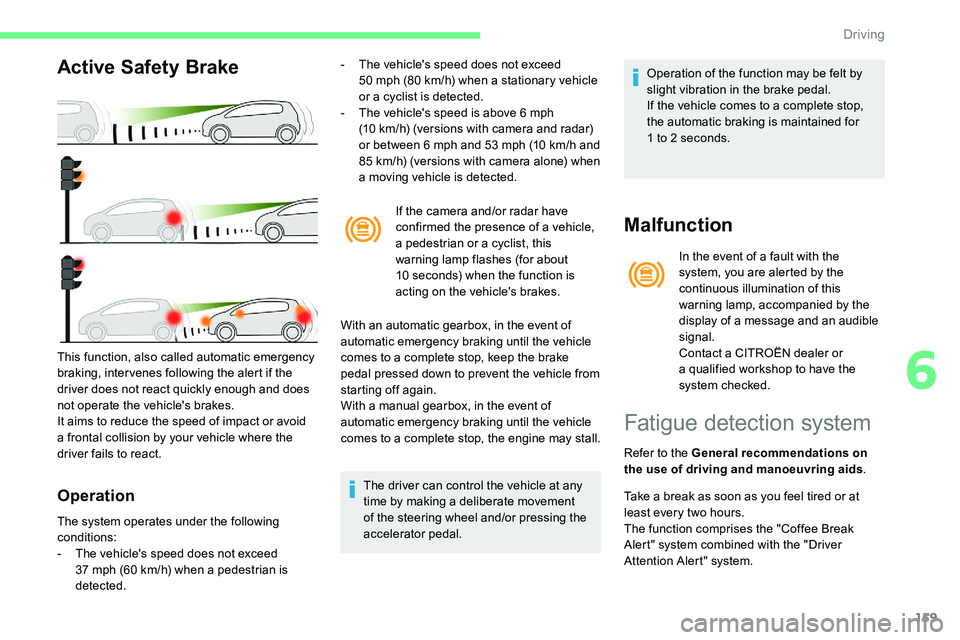display CITROEN C5 AIRCROSS DAG 2020 Handbook (in English)
[x] Cancel search | Manufacturer: CITROEN, Model Year: 2020, Model line: C5 AIRCROSS DAG, Model: CITROEN C5 AIRCROSS DAG 2020Pages: 292, PDF Size: 8.59 MB
Page 151 of 292

149
With an EAT8 gearbox, following braking of
t he vehicle bringing it to a complete stop,
if the traffic conditions do not allow the
vehicle to be restarted within the 3
seconds
following immobilisation, press button 4
or the
accelerator pedal to start off again.
If the driver takes no action following this
immobilisation, the electric parking brake is
applied automatically after about 5
minutes.
Cruise control remains active after
changing gear regardless of the gearbox
type.
When the cruise control is paused,
the message "Activation not possible,
conditions unsuitable" is displayed as
long as reactivation is not possible (safety
conditions not met).
Using the Speed Limit recognition
and recommendation function
F Press 5 to accept the speed suggested by
the function, then press again to confirm. To prevent any sudden acceleration or
deceleration of the vehicle, select a
speed
setting fairly close to the current speed of
your vehicle.
Changing the inter-vehicle distance
F Press 6 to display the distance setting
thresholds ("Distant", "Normal", "Close"),
then press again to select an option.
After a
few seconds, the option is accepted and
will be memorised when the ignition is switched
of f.
Temporarily exceeding the speed
setting
F Press the accelerator pedal. Distance monitoring and cruise control are
deactivated as long as you continue to
accelerate. "Cruise control suspended" is
displayed.
Deactivating the system
F Turn the thumbwheel 1 upwards to the OFF
position.
Displays in the instrument panel
The following information can be seen in the
instrument panel in "DRIVING" display mode. 7.
Vehicle detected by the system (symbol
full).
8. Cruise control active (colour not grey).
9. Value of the speed setting.
10. Speed suggested by the Speed Limit
recognition and recommendation.
11. Vehicle held stopped (versions with
automatic gearbox).
12 . Inter-vehicle distance setting.
13. Position of vehicle detected by the system.
Messages and alerts
The " Driving " display mode of the digital
instrument panel must have been selected first.
6
Driving
Page 152 of 292

150
The display of these messages or alerts is
not sequential."Take back control of the vehicle"
(orange)
"Take back control of the vehicle"
(red) "Activation not possible, conditions
unsuitable". The system refuses to
activate the cruise control (speed
outside the operating range, winding
road).
Stop function
"Cruise control paused" (for a few
se conds).
Stop & Go function
"To move off again: accelerate or
press button 4 " During the vehicle immobilisation phase, it
is recommended:
-
N
ot to open the doors.
-
N
ot to drop off or pick up passengers.
-
N
ot to engage reverse gear.
When the vehicle restarts, watch out for
cyclists, pedestrians or animals which may
not be detected properly.
Operating limits
The cruise control operates by day and night, in
fog or moderate rainfall.
Certain situations cannot be managed by the
system and require driver intervention.
"Cruise control paused" or "Cruise
control suspended" following a
brief
acceleration by the driver.
"Cruise control active", no vehicle
detected.
"Cruise control paused", vehicle
detected.
"Cruise control active", vehicle
detected.
F Brake or accelerate, depending on the context.
F Take immediate control of the vehicle :
the system cannot manage the current
driving situation. The system has brought the vehicle to
a
complete stop and is holding it immobilised:
the cruise control pauses.
The driver must accelerate to move off again,
then reactivate cruise control.
The system has brought the vehicle to
a complete stop.
Within 3 seconds, the vehicle starts off again
automatically and gradually.
After 3 seconds, the driver must accelerate or
press button 4 to move off again.Cases of non- detection by the system:
-
Pe
destrians, some cyclists, animals.
-
S
tationary vehicles (traffic jam, breakdown,
e t c .) .
- V ehicles crossing your lane.
-
V
ehicles driving in the opposite direction.
Driving
Page 153 of 292

151
When the driver must suspend the cruise
control system:Cases where the driver is urged to take
back control immediately:
-
E
xcessively sharp deceleration of the
vehicle in front of you. Pay particular attention:
-
W
hen motorcycles are present and
when there are vehicles staggered
onto the traffic lane.
-
W
hen entering a tunnel or crossing
a
bridge.
If one of these malfunctions occurs, do not
use the system:
-
F
ollowing an impact on the windscreen
close to the camera or on the front
bumper (versions with radar).
-
B
rake lamps not working.
If the vehicle has been subject to one of
the following modifications, do not use the
system:
-
C
arrying long objects on roof bars.
-
To w i n g .
-
U
se of the "space-saver" type spare
wheel (depending on version).
-
F
ront end of the vehicle modified
(addition of long-range headlamps,
painting of the front bumper).Malfunction
- Vehicles in a tight bend.
- W hen approaching a roundabout.
-
W
hen following a narrow vehicle.
Reactivate cruise control when conditions
permit.
-
W
hen a vehicle cuts in sharply between
your vehicle and the one in front. If the cruise control
malfunctions, dashes are
displayed instead of the
cruise control speed setting.
If this warning lamp comes
on, accompanied by an
alert message and an
audible signal, this confirms
a
malfunction.
Have the system checked by a
CITROËN
dealer or a
qualified workshop.
Active Lane Keeping
Assist
Refer to the General recommendations on
the use of driving and manoeuvring aids.
Using a
camera located at the top of the
windscreen, the system identifies lane
markings and steers the vehicle inside this lane
to keep it in the lateral position chosen by the
driver.
6
Driving
Page 154 of 292

152
Conditions for operation
- The adaptive cruise control must be active.
- T he vehicle must be travelling in a traffic
lane clearly delimited by lines on both sides.
-
T
he ESC system must be operating.
-
T
he ASR /DSC systems must not be
deactivated.
-
N
o trailer detected.
-
A s
pare wheel of the "space-saver" type
must not be in use.
-
T
he vehicle must not be subject to strong
lateral accelerations.
-
T
he direction indicators must not be
activated.
Activation/Deactivation
The state of the system stays in the
memory when the ignition is switched off.
The colour of the symbol depends on the
operating state of the system: (grey colour)
At least one of the operating
conditions is not met, the system is
paused.
(green colour)
All operating conditions are met, the
system is active. If the driver no longer wishes to benefit from
the system for a
while, they can deactivate it by
pressing the button again.
The indicator lamp in the button goes off and
the symbol disappears from the instrument
panel.
Cruise control
The driver must hold the steering wheel
properly.
When cruise control is activated, the symbol is
displayed in green: by small steering actions,
the system directs the vehicle and keeps it in
the position chosen by the driver, in the traffic
lane.
The driver can feel movements in the steering
wheel.
This position is not necessarily the centre of
the lane.
The driver can change the position of the
vehicle at any time, by turning the steering
wheel. When the driver feels that the vehicle's
position is appropriate, whilst keeping hands
on the steering wheel, they must release the
pressure to let the system resume control of the
steering, but the vehicle is not centred within
the lane automatically.
This function is primarily suitable for driving on
motor ways and main roads.
F With the adaptive cruise control activated, press this
button.
The action is confirmed by:
-
I
llumination of the indicator lamp in the button in green.
-
D
isplay of the following symbol in the instrument panel.
(orange colour)
The system has a fault.
Driving
Page 155 of 292

153
Pausing/Suspension of the
system
The driver must inter vene as soon as
they believe that the traffic conditions or
the state of the road sur face make this
necessary, by moving the steering wheel
to suspend the system temporarily. Any
action at the brake pedal which results in
the cruise control being paused will also
cause the system to be paused.
If the system detects that the driver is
not holding the wheel firmly enough, it
triggers a series of gradual alerts and then
deactivates itself if there is no reaction
from the driver.
After suspension due to the prolonged
release of the force holding the steering
wheel, you must reactivate the function by
pressing the button again. Automatic pausing:
-
T
riggering of the ESC.
-
P
rolonged failure to detect one of the lane
limit markings. In this case, the active lane
departure warning function can take over,
and the system will reactivate itself once the
operating conditions are again met.
On action by the driver: suspension
-
A
ctivation of the direction indicators.
-
T
ravelling outside the lane limits.
-
T
oo tight a grip on the steering wheel or
dynamic action on the steering wheel.
-
A
ction on the brake pedal (pausing until the
cruise control is reactivated) or accelerator
pedal (suspension for as long as the pedal
is pressed).
-
P
ausing the cruise control.
-
D
eactivation of the DSC/ASR systems.
Driving situations and
associated alerts
The tables below describe the displays
associated with the main driving situations. The
display of these alerts is not sequential.
6
Driving
Page 156 of 292

154
70
70
Indicator lamp in
the buttonSymbol
Cruise control wheel DisplayAssociated
messageComments
Off -"OFF" --None of the functions are activated.
Off -"CRUISE"
(grey colour)"Cruise control
paused" The Active Lane Keeping Assist
function is not activated, the cruise
control is paused.
Off -"CRUISE"
(green colour)"Cruise control on" The Active Lane Keeping Assist
function is not activated, the cruise
control is active.
Green
(green colour) "CRUISE"
or
(green colour) "Cruise control
and Lane Keeping Assist function active" The Highway Driver Assist operates
normally.
Green (grey colour) "CRUISE"
or
(grey colour) "Cruise control
and Lane Keeping Assist function paused" The system has been paused
automatically or by driver action.
Driving
Page 157 of 292

155
70
70
Indicator lamp in
the buttonSymbol
Cruise control wheel DisplayAssociated
messageComments
Green
(grey colour) "OFF"
-"Activate the cruise
control to use the Lane Keeping
Assist function" All operating conditions are met except
activation of the adaptive cruise control.
Green (grey colour) "CRUISE"
or
(green colour) "Unsuitable
conditions –
Activation on stand-by" All conditions required for lateral
control have not been met.
Off -"CRUISE"
or
(green colour) "Hold the wheel" The driver is not holding the steering
wheel correctly and has not taken
notice of the warnings (messages
and audible alarm): the Active Lane
Keeping Assist function is switched off.
Green (grey colour) "CRUISE"
or
(grey colour) "Retake control"
The cruise control can no longer
ensure lateral and longitudinal control:
the driver must retake control of the
vehicle (acceleration or braking). The
alert is accompanied by an audible
signal.
6
Driving
Page 159 of 292

157
The system also takes motorcyclists and
animals into account; however, animals
below 0.5 m tall and objects on the road
are not necessarily detected.
This system is comprised of three functions:
-
C
ollision Risk Alert,
-
I
ntelligent emergency braking assistance,
-
A
ctive Safety Brake (automatic emergency
b r ak ing).
The vehicle has a
multifunctional camera
located at the top of the windscreen, and,
depending on version, a radar located in the
front bumper. As soon as the system detects a
potential
obstacle, it prepares the braking circuit in
case automatic braking is needed. This
may cause a
slight noise and a slight
sensation of deceleration.
Deactivation/Activation
By default, the system is automatically
activated at every engine start.
This system can be deactivated or
activated via the Driving /Vehicle
menu of the touch screen.
Deactivation of the system is
signalled by the illumination of this
indicator lamp, accompanied by the
display of a
message.
Operating conditions and
limits
The ESC system must not be faulty.
The DSC/ASR systems must not be
deactivated.
All passenger seat belts must be fastened.
Driving at a steady speed on roads with few
bends is required. In the following cases, deactivating the system
via the vehicle's configuration menu is advised:
-
t
owing a trailer,
-
c
arrying long objects on roof bars or roof
rack,
-
w
ith snow chains fitted,
-
b
efore using an automatic car wash, with
the engine running,
-
b
efore placing the vehicle on a rolling road
in a workshop,
-
t
owed vehicle, engine running,
-
d
amaged front bumper (version with radar),
-
f
ollowing an impact to the windscreen close
to the detection camera.
The system is automatically deactivated
after the use of certain "space-saver"
type spare wheels is detected (smaller
diameter).
The system is automatically deactivated
after detection of a fault with the brake
pedal switch or with at least two brake
lamps.
It is possible that warnings are not given,
are given too late or seem unjustified.
Consequently, always stay in control of
your vehicle and be prepared to react at
any time to avoid an accident.
6
Driving
Page 160 of 292

158
Collision Risk Alert
It warns the driver if their vehicle is at risk of
collision with the vehicle in front or a pedestrian
present in their traffic lane.
Modifying the alert trigger
threshold
This threshold determines how you wish
to be alerted of the presence of a moving
or stationary vehicle in front of you, or
a
pedestrian or cyclist present in your traffic
lane.
The current threshold can be
modified via the Driving /Vehicle
menu of the touch screen.
You can select one of three predefined
thresholds:
-
"Distant ",
-
"Normal ",
-
"Close ".
The last threshold selected is memorised when
the ignition is switched off.
Operation
Depending on the degree of risk of collision
detected by the system and the alert threshold
chosen by the driver, several different levels
of alert may be triggered and displayed in the
instrument panel.
They take account of the vehicle dynamics, the
speed of your vehicle and the one in front, the
environmental conditions and the operation of
the vehicle (cornering, actions on the pedals,
etc.) to trigger the alert at the best moment.
Level 1 (orange) : visual alert only,
signalling to you that the vehicle in
front is very close.
The " Vehicle close " message is
displayed.
Level 2 (red) : visual and audible
alert, warning you that a
collision is
imminent.
The message " Brake!" is displayed.
Level 3 : finally, in some cases, a
haptic alert in the form of micro-
braking can be given, confirming the
risk of collision. Where the speed of your vehicle is too
high when approaching another vehicle,
the level 2
alert may be displayed
immediately.
Important: the level 1
alert is never
displayed for a
stationary obstacle or
when the " Close" trigger threshold has
been selected.
Intelligent emergency
braking assistance
If the driver brakes, but not sufficiently to avoid
a collision, this system will supplement the
braking, within the limits of the laws of physics.
This assistance will only be provided if you
press the brake pedal.
After an impact, the function automatically
stops operating. Contact a
CITROËN
dealer or a
qualified workshop to have the
system checked.
Driving
Page 161 of 292

159
Active Safety Brake
Operation
- The vehicle's speed does not exceed 50 mph (80 km/h) when a stationary vehicle
or a
cyclist is detected.
-
T
he vehicle's speed is above 6 mph
(10
km/h) (versions with camera and radar)
or between 6
mph and 53 mph (10 km/h and
85
km/h) (versions with camera alone) when
a
moving vehicle is detected.If the camera and/or radar have
confirmed the presence of a
vehicle,
a pedestrian or a
cyclist, this
warning lamp flashes (for about
10
seconds) when the function is
acting on the vehicle's brakes.
With an automatic gearbox, in the event of
automatic emergency braking until the vehicle
comes to a
complete stop, keep the brake
pedal pressed down to prevent the vehicle from
starting off again.
With a
manual gearbox, in the event of
automatic emergency braking until the vehicle
comes to a
complete stop, the engine may stall.
The driver can control the vehicle at any
time by making a
deliberate movement
of the steering wheel and/or pressing the
accelerator pedal. Operation of the function may be felt by
slight vibration in the brake pedal.
If the vehicle comes to a
complete stop,
the automatic braking is maintained for
1
to 2 seconds.
Malfunction
In the event of a fault with the
s ystem, you are alerted by the
continuous illumination of this
warning lamp, accompanied by the
display of a
message and an audible
signal.
Contact a
CITROËN dealer or
a
qualified workshop to have the
system checked.
This function, also called automatic emergency
braking, inter venes following the alert if the
driver does not react quickly enough and does
not operate the vehicle's brakes.
It aims to reduce the speed of impact or avoid
a
frontal collision by your vehicle where the
driver fails to react.
The system operates under the following
conditions:
-
T
he vehicle's speed does not exceed
37
mph (60
km/h) when a
pedestrian is
detected.
Fatigue detection system
Refer to the General recommendations on
the use of driving and manoeuvring aids .
Take a
break as soon as you feel tired or at
least every two hours.
The function comprises the "Coffee Break
Alert" system combined with the "Driver
Attention Alert" system.
6
Driving